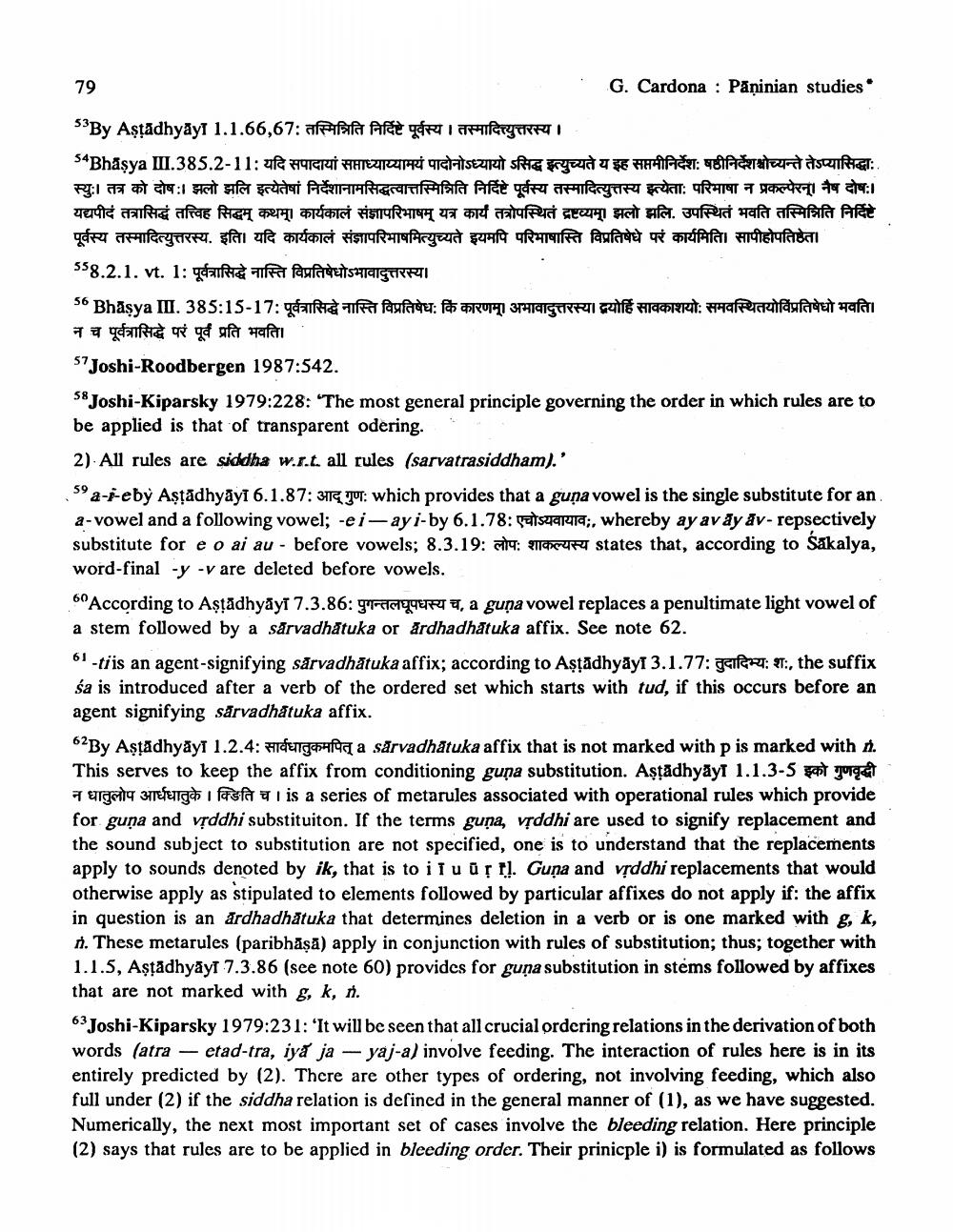________________
79
.
G. Cardona : Pāṇinian studies
By Așțădhyay 1.1.66,67: afAMA After ferihityTRI S4Bhasya III.385.2-11: af AGRİ HATEZPIPARI TEMATSzirt shared E HIAT: 981&atuten seit: स्युः। तत्र को दोषः। झलो झलि इत्येतेषां निर्देशानामसिद्धत्वात्तस्मिन्निति निर्दिष्टे पूर्वस्य तस्मादित्युत्तस्य इत्येता: परिभाषा न प्रकल्पेरन्। नैष दोषः। यद्यपीदं तत्रासिद्धं तत्त्विह सिद्धम् कथम्। कार्यकालं संज्ञापरिभाषम् यत्र कार्य तत्रोपस्थितं द्रष्टव्यम्। झलो झलि. उपस्थितं भवति तस्मिन्निति निर्दिष्टे पूर्वस्य तस्मादित्युत्तरस्य. इति। यदि कार्यकालं संज्ञापरिभाषमित्युच्यते इयमपि परिभाषास्ति विप्रतिषेधे परं कार्यमिति। सापीहोपतिठेत। 558.2.1. vt. 1: date for PaufadetsHTAISTIRTI 56 Bhasya III. 385:15-17: In fa paurada: P RUTH THIAGUIRIGIE HIcarr: Haraldufar det hafal न च पूर्वत्रासिद्धे परं पूर्व प्रति भवति। 57 Joshi-Roodbergen 1987:542. 58 Joshi-Kiparsky 1979:228: The most general principle governing the order in which rules are to be applied is that of transparent odering. 2). All rules are siddha w.l.t. all rules (sarvatrasiddham).' 59a-i-eby Aştādhyāyi 6.1.87: 3175 TOT: which provides that a guna vowel is the single substitute for an a-vowel and a following vowel; -ei- ay i- by 6.1.78: galsarita;, whereby ay avây ăv- repsectively substitute for e o ai au - before vowels; 8.3.19: : URI states that, according to Sakalya, word-final -y - v are deleted before vowels. 6 According to Aşpadhyayi 7.3.86: galeria, a guna vowel replaces a penultimate light vowel of a stem followed by a sārvadhatuka or ardhadhatuka affix. See note 62. 61 -tiis an agent-signifying sārvadhātuka affix; according to Aşțădhyāyi 3.1.77: gart: :, the suffix sa is introduced after a verb of the ordered set which starts with tud, if this occurs before an agent signifying sārvadhatuka affix. 62By Asțădhyay 1.2.4: Hidangafta a sārvadhâtuka affix that is not marked with p is marked with . This serves to keep the affix from conditioning guna substitution. Astådhyāyt 1.1.3-5 sant Jorge न धातुलोप आर्धधातुके । विङति च । is a series of metarules associated with operational rules which provide for guna and vrddhi substituiton. If the terms guna, vȚddhi are used to signify replacement and the sound subject to substitution are not specified, one is to understand that the replacements apply to sounds denoted by ik, that is to itu ūļ tl. Guna and vȚddhi replacements that would otherwise apply as stipulated to elements followed by particular affixes do not apply if: the affix in question is an ardhadhatuka that determines deletion in a verb or is one marked with g, k, n. These metarules (paribhasa) apply in conjunction with rules of substitution; thus; together with 1.1.5, Așțådhyāyt 7.3.86 (see note 60) provides for guna substitution in stems followed by affixes that are not marked with g, k, n. 63 Joshi-Kiparsky 1979:231: 'It will be seen that all crucial ordering relations in the derivation of both words (atra - etad-tra, iya ja -yaj-a) involve feeding. The interaction of rules here is in its entirely predicted by (2). There are other types of ordering, not involving feeding, which also full under (2) if the siddha relation is defined in the general manner of (1), as we have suggested. Numerically, the next most important set of cases involve the bleeding relation. Here principle (2) says that rules are to be applied in bleeding order. Their prinicple i) is formulated as follows




